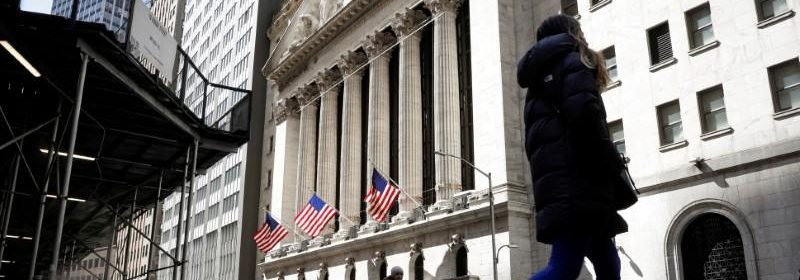Wall Street heads for weak open as investors review recovery bets

LONDON (Reuters) – Wall Street headed for a weak start on Friday as investors reassessed their bets on recovery plays after the U.S. Federal Reserve’s hawkish stance further fuelled the dollar, while denting prices of commodities and other reflation plays.
U.S. stock futures were down 0.5% to 0.7% with losses accelerating an hour ahead of the market open, when St. Louis Federal Reserve president James Bullard told CNBC that inflation was more intense than expected.
Those comments sent the U.S. dollar index to 92.074, the highest in more than two months, and U.S. 10-year Treasury yields back above 1.5% after Thursday’s drop. [US/]
“It’s a bit of dust settling, with no panic and the grown up reaction is encouraging,” said Ned Rumpeltin, European Head of Currency Strategy at TD Securities.
While the Fed messaging on Wednesday indicated no clear end to supportive policy measures such as bond buying, signals of faster-than-expected rate hikes indicated its concern about inflation as the U.S. economy recovers from the COVID-19 pandemic.
The comments led to moves like the U.S. Treasury yield curve rolling over dramatically and sending the dollar higher, helping to suck momentum out of reflation trades that bet on recovery.
“The Fed was very important for market psychology and will continue to resonate for some time, but we knew it was coming and it was just a question of when after the U.S. and global economies improved,” Rumpeltin said.
Friday is also “quadruple witching day” on Wall Street when options and futures on stocks and stock indexes expire, which can trigger volatility in markets around the close.
“The popular explanation of the faltering of reflation trades is the belief that growth is peaking while the Fed will keep inflation in check,” said Marija Vertimane, senior strategist at State Street Global Markets.
“We disagree and (are) happy to buy the dip in cyclical stocks,” Vertimane said.
Goldman Sachs said a slip in commodity prices following the Fed’s comments created a buying opportunity.
In Europe, the pan-European STOXX index of shares eased 0.75% to 455.88 points, just below Monday’s record high of 460.51.
The MSCI world equity index was off 0.23% at 713.24 points after hitting a record high of 722.32 on Tuesday, while Paris and Frankfurt were down 0.6% to 1%.
Stocks in London fell 1.18% after data showed British retail sales fell unexpectedly last month as a lifting of lockdown restrictions encouraged spending in restaurants rather than shops.
The dollar was heading for its best week in nearly nine months as investors priced in a sooner-than-expected ending to extraordinary U.S. monetary stimulus.
Strength in the greenback pushed oil lower for a second straight session, while spot gold remained down around 5% for the week after the Fed dented the yellow metal’s safe haven appeal.
INFLATION GENIE
“What is pretty obvious is that the inflation genie is starting to sneak out of the bottle, and that will be a major driver of interest rates in the short to medium term,” said James McGlew, executive director of corporate stockbroking at Argonaut in Perth.
In Europe, analysts were already asking if the Bank of England, whose monetary policy committee meets next week, will follow in the Fed’s footsteps and adopt a more bullish tone on the economy and what that would mean for the path of UK stimulus and interest rates.
In Asia, MSCI’s broadest index of Asia-Pacific shares outside Japan was flat after falling for four sessions. Chinese blue-chip A shares were also little changed, along with Japan’s Nikkei.
Gold prices, which plunged following the Fed comments, edged higher but were still set for their worst week since March 2020. Spot gold was last up 1.1% at $1,792 per ounce. [GOL/]
Higher expectations of inflation continued to lift long-dated U.S. Treasury yields. Benchmark 10-year notes yielded 1.4768%, off 0.034 from a close of 1.511% on Thursday.
The dollar pulled back against the yen to 110.13, and the euro was flat at $1.1909
Oil prices took a hit from the strong dollar as concerns over demand and new Iranian supply also weighed.
Global benchmark Brent crude was down 0.7% at $72.53 a barrel after settling at its highest price since April 2019 on Wednesday. U.S. West Texas Intermediate crude, which touched its highest level since October 2018 on Wednesday, shed 0.66% to $70.57.
Source: Read Full Article
